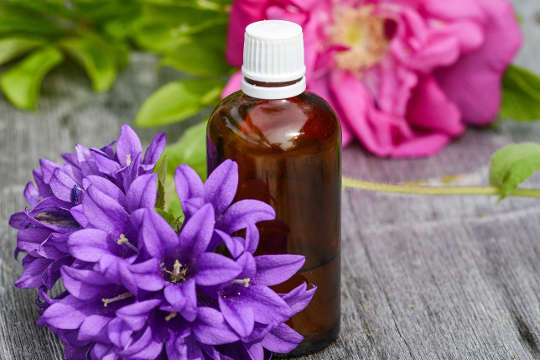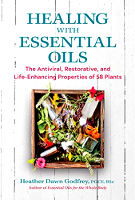
Image by Monika
Essential oils have a multitude of uses, from ethereal and cosmetic to psycho-emotional and medicinal. They are protective and rejuvenating and also act preventively. Most significant of all, though, essential oils are team players (just as they are within the plant), supporting and complementing most body systems. Their qualities also work well with other therapeutic, well-being, beauty, and aesthetic modalities.
Health and wellness are maintained best by acknowledging the cornerstones of well-being:
✦ Eating a fresh, nutritious, balanced diet and remaining sufficiently hydrated (drinking fresh water and eating fresh vegetables and fruits, which also contain water)
✦ Exercise, movement, and mobility
✦ Meditation and relaxation
✦ Love, joy, friendship, and community
Where Essential Oils Shine
There are times when our defense mechanisms are compromised and our resilience weakens, whether through illness, stress, overwork and inadequate rest, shock, anxiety, feelings of insecurity, poor diet, or lack of sufficient sleep. Complementary interventions are useful preventives that help us manage and maintain our health, wellness, and resilience and support recovery, and this is where essential oils really come into their own.
Essential oils work very well preventively, staving off infection and pathogenic invasion. They appear to be especially useful during the early stages of infection, stimulating the immune system into action by promoting the activity of lymphocytes (immune-supporting white blood cells), increasing phagocytosis (the process by which an immune cell uses its plasma membrane to engulf large particles such as viruses or an infected cell), and inducing interferon production (interferons are signaling proteins that “interfere” with viruses to prevent them from multiplying) (Peterfalvi et al. 2019). Thus essential oils support the immune system and support hygiene. They also alleviate symptoms like those associated with colds and flu, such as headache, nasal and sinus congestion, runny nose, cough, and muscle aches, plus all the associated symptoms, including insomnia, depression, and anxiety.
Get The Latest By Email
Significantly, unlike conventional antibiotics, essential oils do not disrupt the body’s microbiome. This is not to say they are not capable of doing so or that the immune system will not develop resistance to them—the molecular complexity of essential oils means resistance may be delayed through their use but not necessarily prevented, especially if they are repeatedly overused. This is why it is advisable to be moderate in the use of essential oils: use higher amounts for short duration during infection and modest amounts when used as a preventive or when used in skin-care products or for psycho-emotional applications.
Always remember that essential oils work very well in very small amounts. And it is advisable to frequently change the essential oil or essential oil blend you use, with periods of abstinence or breaks from using essential oils.
Antimicrobial Properties of Essential Oils
All essential oils possess antimicrobial properties to varying degrees. Essential oils inhibit and slow the growth of bacteria, yeasts, and molds, and their molecules affect the lipid structure of bacterial cell membranes in a way that increases their permeability, causing those cells to lose ions and other cellular components, which leads to cell death. As well, essential oils can act synergistically, potentiating other antiviral or medicinal agents, including biomedical antibiotics (Da Silva et al. 2020, Nazzarro et al. 2013).
Some essential oils possess broad-spectrum bactericidal and antiviral qualities, while others are more specific in their action depending on the chemical composition of the essential oil and the type of microbe or virus. Broad spectrum in this context does not mean a single essential oil or blend of essential oils will kill all viruses or all bacteria, though. Essential oils are generally and variously tissue-regenerating, antiviral, antibacterial, antifungal, anti-inflammatory, mucolytic, and more, and as observed in the previous chapter, considered blending of essential oils with regard to their chemical composition can potentiate their strength, increase their range of action, and quell irritant effects, with certain molecules counterbalancing the less desirable effects of others. In fact, blending essential oils goes a long way toward decreasing the risk of microbial resistance.
The Psycho-Emotional Influence of Essential Oils
A wisp of scent is enough to immediately transport us on a sensory journey—a jasmine kiss on a starlit night; a rose garden in summer; the earthy-agrestic woodiness of a northern forest in the spring; Mediterranean citrus groves in the winter; a woody-smoky log fire on a cool, dusky evening; spicy, warm fruitcake fresh from the oven; sunshine on the cloudiest day.
Tones, colors, and shades, nuances that seamlessly imbue from conjured images, memories, and impressions complex and deep, often experienced beyond words, are all sensually illuminated by the gift of smell. Magical! Yet scent detection is initially instigated by a chemical response.
When we smell and acknowledge the scent of a flower or a fruit, or even the scent of the soft skin of a newborn, we are responding to messages instigated by odor molecules permeating our immediate environment.
Scent molecules—terpenes and terpenoids—are detected like a key in a lock by our olfactory receptors, located at the top of each nasal cavity; these in turn relay nerve impulses to the limbic system, located in the brain. Odor receptors are found in other parts of the body, as well, such as in the skin and other organs. However, by grand design it seems, proximity of the master olfactory portal guarantees immediate awareness and an instinctive reflexive response. Initially, we instantly decipher whether something is safe or noxious (do we accept or reject it?). But scent recognition is a complex process.
Depending on the nature of the stimuli, the sympathetic nervous system prepares the body for fight or flight (protection), and the parasympathetic nervous system maintains a state of peace and relaxation (rest and digest) and disengages the sympathetic nervous system from post-alert states, returning the body to its optimal functional resting state.
Initially, our response to an essential oil is reflexive, based on whether we like or dislike its scent—a simple, subjective response, and not an unreasonable indicator of whether the oil is good or bad for us.
Essential oils, though, are multidynamic. As well as being antimicrobial and beautifully perfumed, they aid mental alertness and memory and instigate positive psycho-emotional states such as feeling uplifted, calm and grounded, clear-headed, invigorated, and bright and wakeful.
Essential oils are secondary metabolites, produced as an indirect consequence of photosynthesis in certain plants. Most essential oil-bearing plants are found in areas just north or south of the equator, where the sun is closest to Earth. Thus plants that give us essential oils are intrinsically linked and responsive to the ebb and flow of changing seasons and patterns of available light, as well as to such environmental conditions as temperature, moisture, and atmospheric pressure—just as we humans are.
Essential Oils through the Seasons
Essential oils can journey with us through the seasons both actually and metaphorically, protecting and supporting us while we recalibrate and adjust to changing conditions. By harmonizing body, mind, and spirit, essential oils are stabilizing and grounding.
For example, frankincense and myrrh have earthy, warming, drying, antimicrobial, and calming qualities. They support the immune system, stave off colds and flu, and serve as a good antidote to the dampness of winter. When combined with bitter orange or another citrusy oil, they also dispel feelings of anxiety and depression.
Mandarin and the earthy-smoky scent of vetivert, combined with the sweet, roselike scent of geranium, express similar uplifting yet grounding qualities. These essential oils can be used to support the transition from autumn to winter and may also aid conditions such as seasonal affective disorder (SAD). Cypress, rose, and lavender aid the transition from spring to summer.
Cypress inspires us to metaphorically walk tall and move on as we step out of winter’s cave. Rose, the queen of oils, blesses us with a sense of beauty and rejuvenation, while lavender gifts us with its calming, uplifting, and protective qualities. Try it and see for yourself! Indeed, there are so many essential oils to choose from, and it just takes a few carefully selected oils to create your own scent pharmacopeia. Your sense of smell will guide your choice.
Enjoy the journey!
Copyright 2022. All Rights Reserved.
Printed with permission.
Article Source
BOOK: Healing with Essential Oils
Healing with Essential Oils: The Antiviral, Restorative, and Life-Enhancing Properties of 58 Plants
by Heather Dawn Godfrey PGCE BSc Presenting an accessible yet scientifically based guide to healing with essential oils, this book provides a must-have reference for those who use essential oils at home, for health and well-being practitioners, for scent artists and blend creators, or for anyone wanting to explore the dynamic qualities of essential oils for themselves.
Presenting an accessible yet scientifically based guide to healing with essential oils, this book provides a must-have reference for those who use essential oils at home, for health and well-being practitioners, for scent artists and blend creators, or for anyone wanting to explore the dynamic qualities of essential oils for themselves.
For more info and/or to order this book, click here. Also available as a Kindle edition.
About the Author
 Heather Dawn Godfrey, PGCE, BSc, is an aromatherapist, fellow of the International Federation of Aromatherapists, and an aromatherapy teacher. She has published a number of articles and research papers exploring the benefits of essential oils. She is also the author of Essential Oils for the Whole Body and Essential Oils for Mindfulness and Meditation.
Heather Dawn Godfrey, PGCE, BSc, is an aromatherapist, fellow of the International Federation of Aromatherapists, and an aromatherapy teacher. She has published a number of articles and research papers exploring the benefits of essential oils. She is also the author of Essential Oils for the Whole Body and Essential Oils for Mindfulness and Meditation.
Visit her website at: aromantique.co.uk
More books by this Author.








